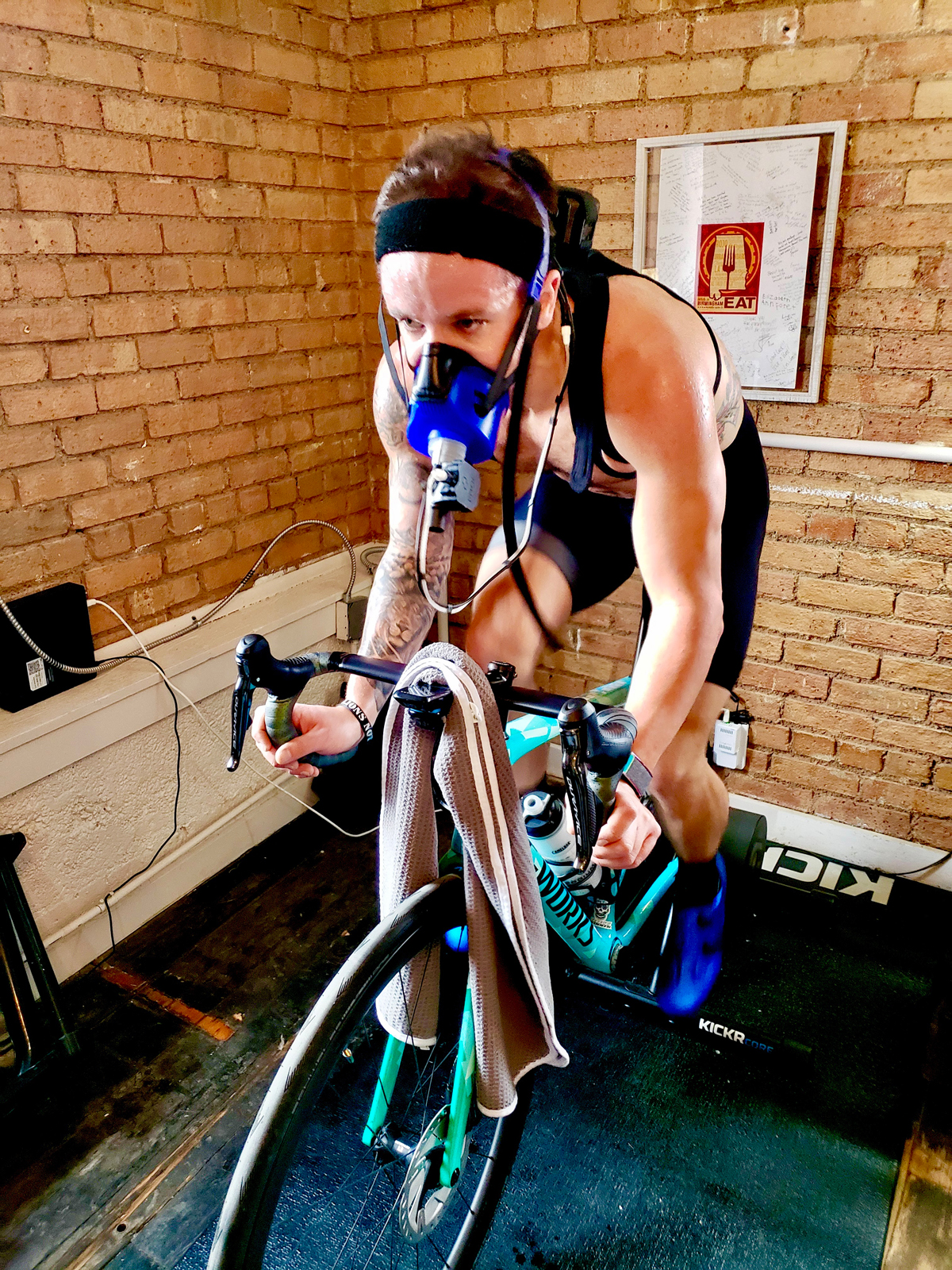By Heather Casey, CSCS, Pn2 — Most of us choose to improve both health and performance through exercise, not one over another. When it comes to reaping the best results from your training program, metabolic analysis is the gold standard. Not only is metabolic analysis scientifically based, but it’s proven to work. Keep reading to find out how metabolic analysis will help you reach the results you seek!
Before we dive in, let’s clear something up. Sports performance services like metabolic testing are not just for elite athletes. The information provided through metabolic testing will allow riders to set more accurate training zones for heart rate and power based on your physiology rather than calculated mathematically using a single number, FTP derived from a Functional Threshold test. Accurate zoning based on physiology highlights areas of metabolic inefficiency. With appropriate programming, your metabolic efficiency will allow you to drive the aerobic engine with a broader range of power and heart rate. This translates to increasing your magical mitochondria density, the ultimate source of energy at the cellular level.

Furthermore, caloric requirements and macronutrients don’t have to be so confusing. When to eat, what to eat, and knowing if the quantities and timing of food are helping fuel your body properly is no longer in question with metabolic analysis.
Through metabolic analysis, we look at the relationship of Oxygen to Carbon Dioxide and determine where you are most efficient, at what heart rate your training is most sustainable, and what fuel your body uses to supply energy. We define where your intensity starts and optimize your program to manage your metabolic stress to lead you to ultimate health and performance!
1. Track Progress That Isn’t Visible
Metabolism, from the Greek root metabole or to change, is a term describes the chemical processes that occur within a living organism in order to support life. In basic terms, metabolism is how your body converts food into energy needed for survival and activity. Just because you don’t visibly see a change in your body doesn’t mean there isn’t transformation going on inside. It’s common for a client to seek metabolic testing after they’ve become metabolically impaired. This is a common result of extreme dieting as it can significantly slow down the metabolism. As we lose weight, our metabolism slows down because there is less body weight to support. So how do you lose weight without tanking your metabolism? You do it with a balance of dietary changes and exercise specific to your individual needs.
It’s important to understand the way your body works using scientifically proven measures. If you are putting in the work with the correct training advice but not seeing results, remain patient! Metabolic analysis and periodic retesting will let you know whether you are wasting your time, or if you’re on the right track.
2. Cardio, Strength, or Interval Training?
Everyone’s body is different. This makes sense considering how we require different amounts of food and calories to meet our individual needs. But did you know that the level, intensity, and type of exercise that you engage in should also be designed specifically for you? There is no “one size fits all”, as individuals we react differently to set workout routines. It all depends on the individual’s metabolism and body type. The results from your metabolic analysis can help develop an individualized training program that provides visible, long-lasting results.
3. Create Personalized Training Zones
Another way metabolic analysis will help you train more intelligently is by being able to determine optimal training zones based on how your body uses the fuel sources fat and carbohydrate. It can help develop appropriate caloric targets, training zones and even calibrate your wearable device like Apple Watch or Garmin. As the saying goes, train smarter, not harder! Tailored training zones will help you gain muscle, maximize fat-burning abilities, and achieve your goals.
4. Prioritize Metabolic Base Training First
One of the most misunderstood types of training is metabolic base training. Athletes often don’t understand how slowing down will pay off overall. Through metabolic analysis, we demonstrate its importance. There are two basic energy systems you use when training: anaerobic and aerobic. Unfortunately, you can’t build both your aerobic and anaerobic systems at the same time very well. The idea behind base training is to train your aerobic energy system specifically.
Why is this important? The more work you perform aerobically, or in the presence of oxygen, the more efficient you are. Prolonged aerobic training produces muscular adaptations that improve oxygen transport to the muscles, reducing the rate of lactate formation, improving the rate of lactate removal, and increasing energy production and utilization. These adaptations occur slowly over time. Fat is a primary fuel source for the aerobic energy system. Over the course of a base period, your body learns to break down and use fat as an energy source more efficiently. As an added bonus, this adaptation helps post-exercise fat metabolism as well.
5. Improve Breathing and Posture
Our breath and its vital life force can be a powerful performance enhancer with proper posture and breathing mechanics, but with poor posture or mechanics diminished by more than 50%. With breath analysis technology we can show you where improvements in your breathing will boost metabolism, improve cognitive function, and increase athletic performance.
Types of Metabolic Testing
Resting Metabolic Test
This analysis allows us to measure your caloric expenditure at rest to design a custom nutrition program to meet your goals for weight loss, conditioning, or muscle gain goals.
Why get a resting metabolic test? Your RMR, resting metabolic rate, is your body’s baseline caloric requirement. Knowing your RMR enables you to:
- Craft individualized calorie intake targets for your goals to help you lose, gain, or maintain your weight.
- Verify if a training or nutrition program has increased or decreased your metabolism
- Compare the speed of your metabolism to others of your gender, age, height, and weight
Active Metabolic Test
Gain unparalleled insight into the systems of your body that generate power. Identify gaps in your fitness profile that can be used to push through plateaus in your training.
The Active Metabolic Test includes:
- Find your ventilatory threshold powers, VO2 Max Fat, and Carb max intensities and utilization rates.
- A look into your Cardiovascular, Respiratory, Cellular, and Neuromuscular function with regards to exercise performance.
- An expert breakdown analysis to form a detailed in-depth view of your physiological profile and current fitness levels.
- Training prescription outline based around your goals and the results of your test sent to you and/or your primary coach.
Conclusion
Although we are highly individualized in our biological design, there are healthy lifestyle choices that can benefit anyone wanting to ignite their metabolic rate. Start by finding your resting metabolic rate, the essential calories needed if you just lay in bed all day. It’s enough calories to keep the heart beating, blood pumping, lungs breathing, everything moving to sustain life. Metabolic testing can provide you with information about how effectively your body burns calories and uses oxygen during workouts. The results from metabolic testing and recommendations can help you make decisions based on your individual needs that will speed up your metabolic rate.
Other healthy habits to adopt for a thriving metabolism are decreasing stress, quality, and adequate sleep, balancing hormones, and strengthening our muscles through weight training.
Scientists know that metabolism varies significantly from one person to another, even after you account for factors such as size and body composition. We still don’t know exactly why this variation occurs, but there are thought to be an entire range of factors, from genetics to organ sizes, the immune system, and even the species of bacteria in their gut microbiome. Breath analysis presents a uniquely valuable tool as it measures the exact number of calories a person’s body is burning, and what fuel sources the body relies on for fuel.
Long-term weight loss and maintenance of a healthy weight can be achieved through responsible methods backed by science and the perspective that hacks, and extreme dieting is not the solution.







